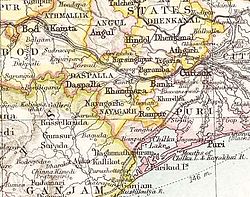History
According to traditions, Nayagarh state was alleged to have been founded by a scion from the Rewa State before 15th century, but lack of written archival historical records marks them as untenable due to the non-alignment of timelines of both Nayagarh and its collateral Khandpara state with that of the corresponding Rewa state which was founded in 1618 succeeding from Bandhavgarh kingdom, which possibly points to its legendary origins due to the historical obscurity. [3] None of the chiefs of Nayagarh appear to have received farmans from either Mughals or Marathas until the Bhonsle Maharaja of Nagpur Raghoji I Bhonsle gifted the chiefs for his assistance during the Maratha conquest of Orissa. [4] Although it is likely that a local chieftain by the name Baghel Singh (1480-1510 CE) who is reputed to be the founder of Nayagarh, as it was known as Baghua Nayagarh, may likely be the founder of the state and also the progenitor of the dynasty with the same name. [5] [6] [7]
Under Raghunath Singh's (1565–1595) successors, Khandpara State which was initially part of Nayagarh State became a separate kingdom in 1599 with his younger son Jadunath Singh inheriting Khandpara while his elder son Harihar Singh continuing at Nayagarh. [5]
The last ruler signed the instrument of accession to the Indian Union on 1 January 1948, merging his state into Odisha forming a part of the Nayagarh district.
This page is based on this
Wikipedia article Text is available under the
CC BY-SA 4.0 license; additional terms may apply.
Images, videos and audio are available under their respective licenses.
